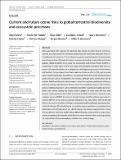Current and future ozone risks to global terrestrial biodiversity and ecosystem processes
Author(s)
Fuhrer, Jürg; Val Martin, Maria; Mills, Gina; Heald, Colette L.; Harmens, Harry; Hayes, Felicity; Sharps, Katrina; Bender, Jürgen; Ashmore, Mike R.; ... Show more Show less
DownloadCurrent and future.pdf (1.322Mb)
PUBLISHER_CC
Publisher with Creative Commons License
Creative Commons Attribution
Terms of use
Metadata
Show full item recordAbstract
Risks associated with exposure of individual plant species to ozone (O[subcript 3]) are well documented, but implications for terrestrial biodiversity and ecosystem processes have received insufficient attention. This is an important gap because feedbacks to the atmosphere may change as future O[subcript 3] levels increase or decrease, depending on air quality and climate policies. Global simulation of O[subcript 3] using the Community Earth System Model (CESM) revealed that in 2000, about 40% of the Global 200 terrestrial ecoregions (ER) were exposed to O[subcript 3] above thresholds for ecological risks, with highest exposures in North America and Southern Europe, where there is field evidence of adverse effects of O[subcript 3], and in central Asia. Experimental studies show that O[subcript 3] can adversely affect the growth and flowering of plants and alter species composition and richness, although some communities can be resilient. Additional effects include changes in water flux regulation, pollination efficiency, and plant pathogen development. Recent research is unraveling a range of effects below-ground, including changes in soil invertebrates, plant litter quantity and quality, decomposition, and nutrient cycling and carbon pools. Changes are likely slow and may take decades to become detectable. CESM simulations for 2050 show that O[subcript 3] exposure under
emission scenario RCP8.5 increases in all major biomes and that policies represented in
scenario RCP4.5 do not lead to a general reduction in O[subcript 3] risks; rather, 50% of ERs still show an increase in exposure. Although a conceptual model is lacking to extrapolate documented effects to ERs with limited or no local information, and there is uncertainty about interactions with nitrogen input and climate change, the analysis suggests that in many ERs, O[subcript 3] risks will persist for biodiversity at different trophic levels, and for a range of ecosystem processes and feedbacks, which deserves more attention when assessing ecological implications of future atmospheric pollution and climate change.
Date issued
2017-03-15Department
Massachusetts Institute of Technology. Department of Civil and Environmental EngineeringJournal
Ecology and Evolution
Publisher
Wiley
Citation
Fuhrer, Jürg, Maria Val Martin, Gina Mills, Colette L. Heald, Harry Harmens, Felicity Hayes, Katrina Sharps, Jürgen Bender, and Mike R. Ashmore. “Current and Future Ozone Risks to Global Terrestrial Biodiversity and Ecosystem Processes.” Ecology and Evolution 6, no. 24 (November 21, 2016): 8785–8799.
Version: Final published version
ISSN
20457758